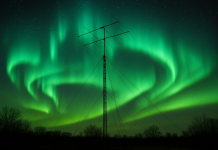Scientists have captured for the first time ever, the weird sound of Earth being hit by a solar storm.
And the noise is pretty eerie!
The first recording is the sound of Earth in normal conditions while the second recording was made during a solar storm. And it turns out, the stronger the storm, the louder the eerie Earth sound.
How Is This Earth Song Created?

Our planet’s magnetic field protects us daily from our life-giving but deadly Sun.
Solar winds are ejected from our star’s atmosphere and flow out into the Solar System, constantly colliding with Earth’s magnetosphere.
During particularly strong solar storms, the particles slam into the outermost region of the magnetic field (Foreshock) with such force that magnetoacoustic waves are generated. This is what you hear is the video above… And below:
The two audio clips in the video feature a ‘sonification’ of the magnetic waves generated in the magnetic Foreshock above Earth.
The first clip was recorded during calm space weather conditions, and the second during a solar storm.
As you might have noticed it, the eerie sounds during a solar storm are higher in pitch and more complicated than those heard during calm conditions.
Discussion about the first audio recordings of Earth being hit by a solar storm has been published in Geophysical Research Letters. Data have been gathered by the Cluster mission, an ESA project aiming at investigating Earth’s magnetic environment.
By the way, discover more eerie sounds from space here…












